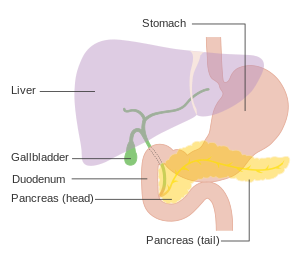Islet cell tumor
| Pancreatic neuroendocrine tumor | |
|---|---|
 |
|
| Classification and external resources | |
| Specialty | Oncology |
| ICD-10 | C25.4 |
| eMedicine | med/ |
Pancreatic neuroendocrine tumors (PanNETs, PETs, or PNETs), often referred to as "islet cell tumors", or "pancreatic endocrine tumors" are neuroendocrine neoplasms that arise from cells of the endocrine (hormonal) and nervous system within the pancreas.
PanNETs are a type of neuroendocrine tumor, representing about one third of gastroenteropancreatic neuroendocrine tumors (GEP-NETs). Many PanNETs are benign, while some are malignant. Aggressive PanNET tumors have traditionally been termed "islet cell carcinoma".
PanNETs are quite distinct from the usual form of pancreatic cancer, the majority of which are adenocarcinomas, which arises in the exocrine pancreas. Only 1 or 2% of clinically significant pancreas neoplasms are PanNETs.
PanNETs are sometimes abbreviated as PETs or PNETs: such use should not to be confused with the primitive neuroectodermal tumor (PNET).
The majority of PanNETs are benign, while some are malignant. The World Health Organization (WHO) classification scheme places neuroendocrine tumors into three main categories, which emphasize the tumor grade rather than the anatomical origin. In practice, those tumors termed well or intermediately differentiated PanNETs in the WHO scheme are sometimes called "islet cell tumors." The high grade subtype, termed neuroendocrine cancer (NEC) in the WHO scheme, is synonymous with "islet cell carcinoma".
...
Wikipedia
